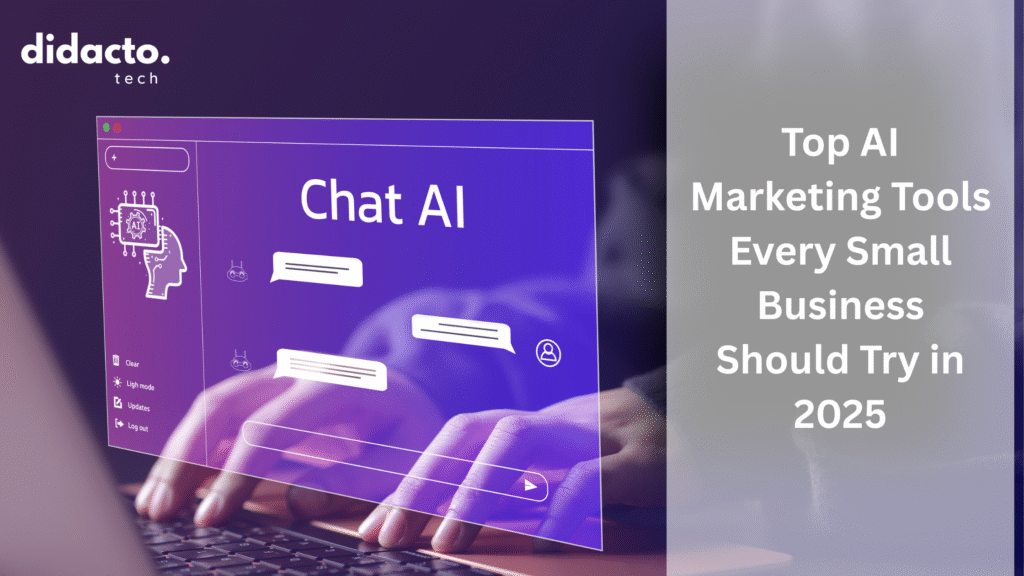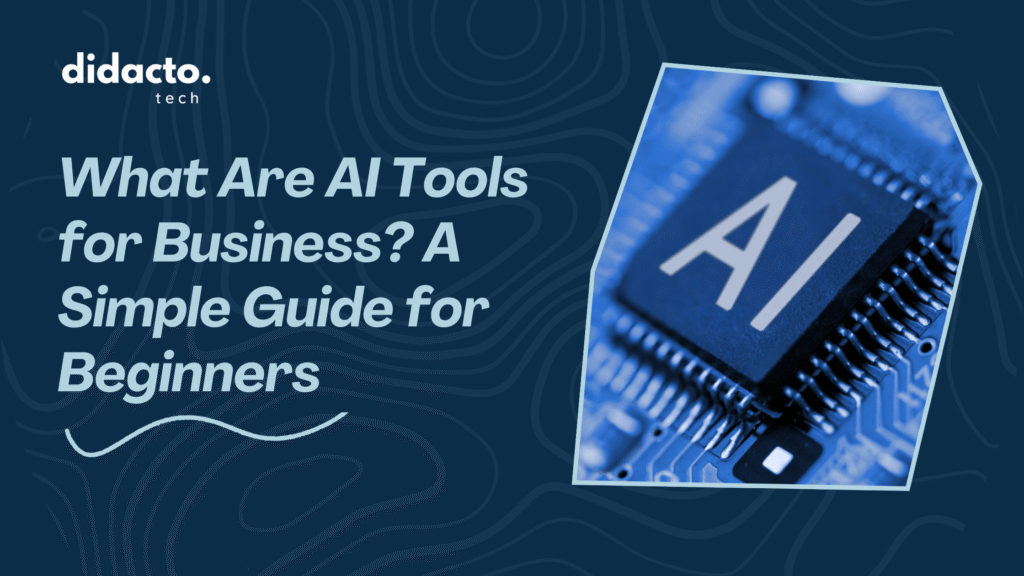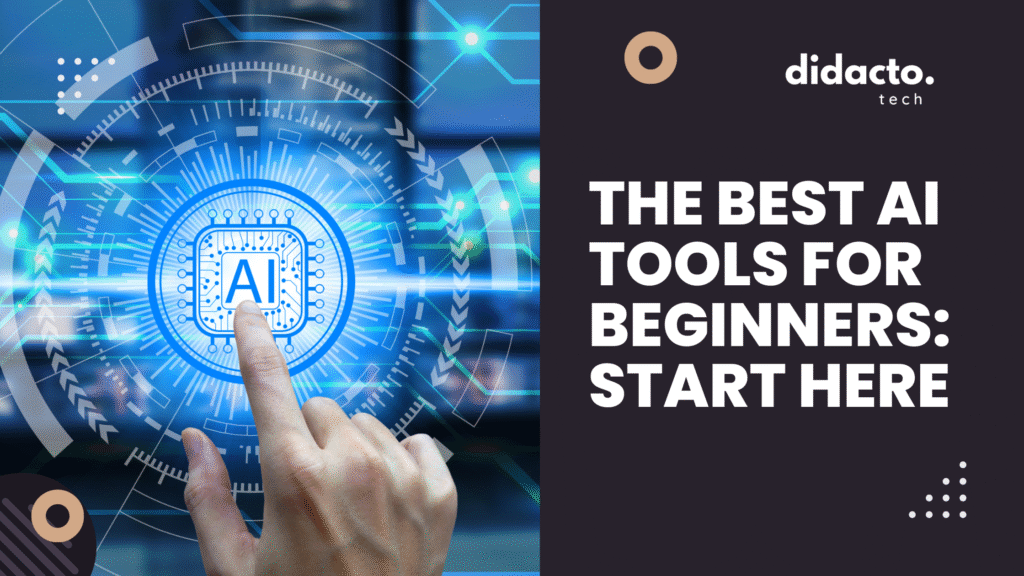Table of Contents
Introduction to AI in Small Business Marketing
What is AI in Marketing?
AI Marketing Tools – Artificial intelligence (AI) in marketing refers to the use of computer systems that can perform tasks typically requiring human intelligence—like understanding language, recognizing patterns, and making decisions. For small businesses, AI means using smart tools to help with things like writing content, analyzing customer behavior, and managing ads. It’s not about replacing people, but about making everyday marketing tasks easier and more effective.
Benefits for Small Businesses
AI marketing tools can be a real game-changer for small businesses. They help save time by automating repetitive tasks, such as scheduling social media posts or sending emails. AI also improves accuracy, reducing the risk of human error in things like data analysis or customer segmentation. Most importantly, these tools can help small businesses reach more customers by personalizing messages and targeting the right audience. In my own experience, using an AI-powered email tool helped me double my open rates without spending extra hours crafting each message.
Common Challenges and Considerations
Of course, adopting AI isn’t always smooth sailing. Cost is often a concern, especially for businesses with tight budgets. Some tools come with monthly fees that can add up. There’s also a learning curve—getting used to new software can take time and patience. Data privacy is another important factor; small businesses need to make sure they’re handling customer information responsibly and following regulations. I remember feeling a bit overwhelmed when I first tried an AI analytics tool, but after a few tutorials, it became much more manageable.
AI Tools for Content Creation and Management
Automated Copywriting Tools
AI copywriting tools like Jasper, Copy.ai, and Writesonic can help generate blog posts, social media captions, and email content in minutes. These platforms use natural language processing to create text that sounds human. For example, I once used Jasper to draft a month’s worth of Instagram captions, and it saved me hours of brainstorming. While the results sometimes need a personal touch, these tools are great for overcoming writer’s block and keeping content calendars full.
Visual Content Generators
Creating eye-catching images and videos is easier than ever with AI tools like Canva’s Magic Media, Lumen5, and DALL-E. These platforms can turn simple text prompts into graphics, infographics, or even short videos. I’ve found that using Canva’s AI features helps me quickly design social media posts that look professional, even if I don’t have a background in graphic design.
Content Planning and Scheduling
Platforms like Buffer, Later, and CoSchedule use AI to help organize, schedule, and optimize content delivery. They analyze the best times to post and can even suggest content ideas based on trends. I personally rely on Buffer to keep my posting consistent, and its AI-powered suggestions have helped me spot topics that resonate with my audience.
AI Solutions for Customer Engagement
Chatbots and Virtual Assistants
AI chatbots like Chatfuel, ManyChat, and Tidio provide instant responses to website visitors, answering common questions and guiding users through the sales process. These tools are available 24/7, which means customers get help even outside business hours. I’ve seen small businesses use chatbots to handle order tracking and FAQs, freeing up staff for more complex tasks.
Personalized Email Marketing
Platforms such as Mailchimp, ActiveCampaign, and Brevo (formerly Sendinblue) use AI to segment audiences and tailor email campaigns. They analyze customer behavior to send the right message at the right time. In my experience, switching to an AI-driven email platform led to more personalized communication and better engagement rates.
Social Media Interaction Tools
Managing comments, messages, and audience engagement can be overwhelming. Tools like Sprout Social and Hootsuite use AI to prioritize important interactions and suggest responses. I’ve found that these platforms help me stay on top of conversations without missing key messages from customers.
AI Tools for Data Analysis and Insights
Customer Behavior Analytics
Understanding how customers interact with your website or app is crucial. Tools like Google Analytics 4, Hotjar, and Mixpanel use AI to track and interpret user actions. They provide insights into what’s working and what needs improvement. I remember being surprised by how much I learned about my website visitors’ habits after setting up Hotjar’s heatmaps.
Marketing Performance Tracking
Platforms such as HubSpot and Zoho Analytics measure campaign effectiveness and suggest improvements. They track metrics like click-through rates, conversions, and ROI, helping small businesses make data-driven decisions. I often use these tools to review which campaigns are delivering the best results and where to adjust my strategy.
Predictive Analytics for Sales and Trends
AI tools like Salesforce Einstein and Pecan AI forecast sales, customer preferences, and market trends. They analyze historical data to predict what might happen next, allowing businesses to plan ahead. While I was initially skeptical, using predictive analytics helped me anticipate seasonal demand and adjust my marketing efforts accordingly.
AI Platforms for Advertising and Lead Generation
Automated Ad Creation and Management
Platforms like AdCreative.ai, Smartly.io, and Google Ads’ AI features design, place, and optimize ads across digital channels. They test different versions of ads to see which performs best. I’ve used AdCreative.ai to quickly generate ad visuals and copy, which made launching new campaigns much faster.
Lead Scoring and Qualification
AI can help identify and prioritize potential customers. Tools like HubSpot and Zoho CRM use algorithms to score leads based on their likelihood to convert. This means sales teams can focus on the most promising prospects. In my own work, lead scoring has helped me avoid wasting time on cold leads and concentrate on those ready to buy.
Retargeting and Audience Segmentation
Reaching previous website visitors and creating targeted ad groups is easier with AI solutions like Facebook Ads Manager and AdRoll. These platforms segment audiences based on behavior and interests, making retargeting more effective. I’ve seen a noticeable increase in return visits and conversions after implementing AI-powered retargeting campaigns.
Choosing and Implementing the Right AI Tools
Assessing Business Needs and Goals
Before jumping into AI, it’s important to evaluate which marketing areas need support. Are you struggling with content creation, customer engagement, or data analysis? I recommend making a list of your biggest marketing challenges and matching them to available AI solutions.
Comparing Features and Pricing
Not all AI tools are created equal. Look for platforms that offer the features you need, are easy to use, and fit your budget. Many tools offer free trials, so you can test them before committing. I always compare at least three options and read user reviews to get a sense of what works best for businesses like mine.
Integrating AI Tools with Existing Systems
Smooth adoption is key. Make sure the AI tools you choose can integrate with your current website, CRM, or email platform. Some tools offer plug-and-play integrations, while others may require a bit more setup. I’ve found that starting with one tool at a time helps avoid overwhelm and ensures a smoother transition.
Conclusion
Key Takeaways
AI marketing tools are becoming more accessible and practical for small businesses. They can save time, improve accuracy, and help reach more customers through smarter content creation, customer engagement, data analysis, and advertising. While there are challenges like cost and learning curves, the benefits often outweigh the hurdles.
Next Steps for Small Businesses
Start by identifying your biggest marketing pain points. Research AI tools that address those needs, compare features and pricing, and take advantage of free trials. Begin with one or two tools, learn how they work, and gradually expand your AI toolkit as you grow more comfortable.
“AI isn’t about replacing your marketing team—it’s about giving them better tools to do their job. Start small, stay curious, and let technology help your business grow.”
Frequently Asked Questions (FAQs)
Are AI marketing tools expensive for small businesses?
Many AI marketing tools offer tiered pricing, including free or affordable plans for small businesses. Costs can vary, so it’s important to compare options and choose tools that fit your budget.
How difficult is it to set up and use these tools?
Most modern AI tools are designed to be user-friendly, with tutorials and customer support available. There may be a learning curve, but many small business owners find the investment in time pays off quickly.
Can AI tools replace human marketers?
AI tools are best used to support, not replace, human marketers. They handle repetitive tasks and provide insights, but creativity and personal connection still require a human touch.
What should I look for when choosing an AI marketing tool?
Consider your business needs, the tool’s features, ease of use, integration options, and pricing. Reading reviews and trying free versions can help you make an informed decision.
How can I measure the success of AI marketing tools?
Track key metrics like time saved, engagement rates, conversions, and ROI. Most AI tools include analytics dashboards to help you monitor performance and make adjustments as needed.



